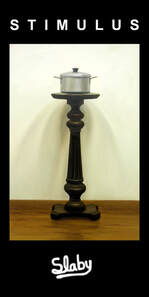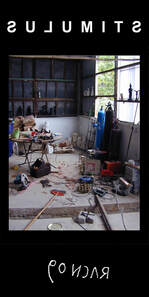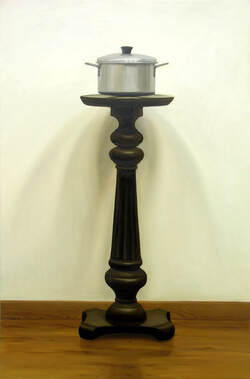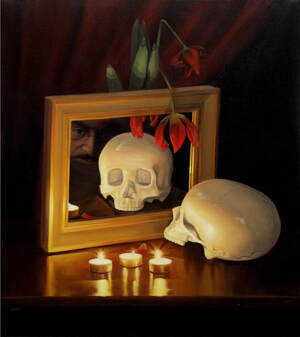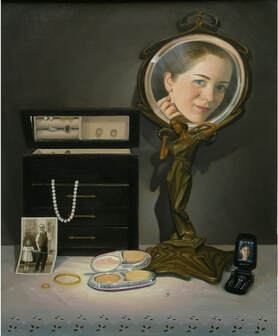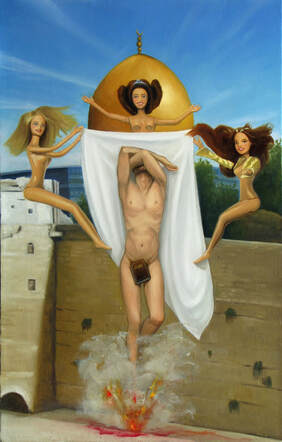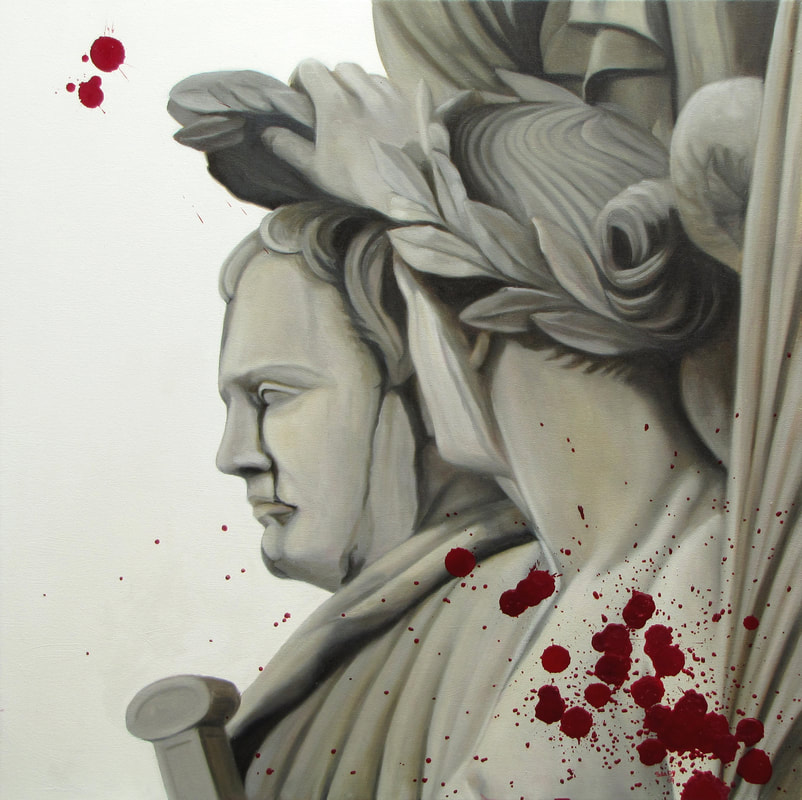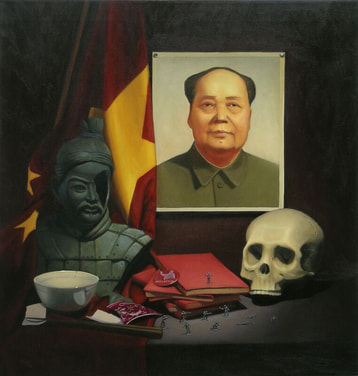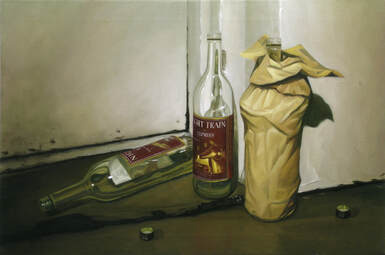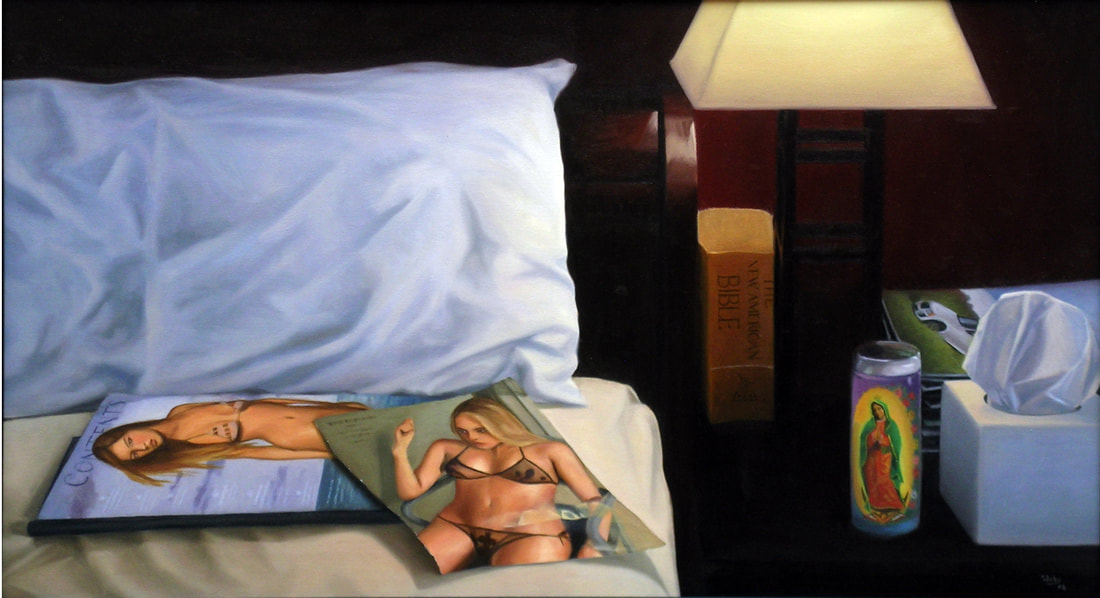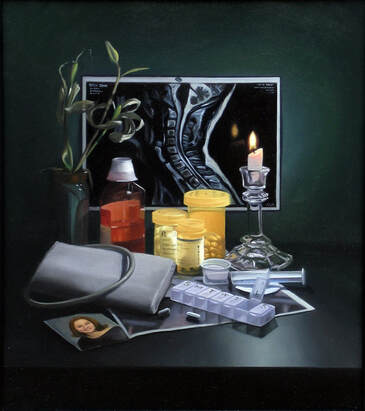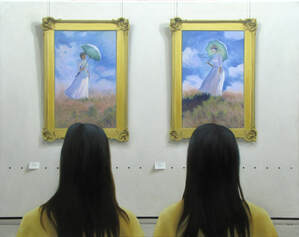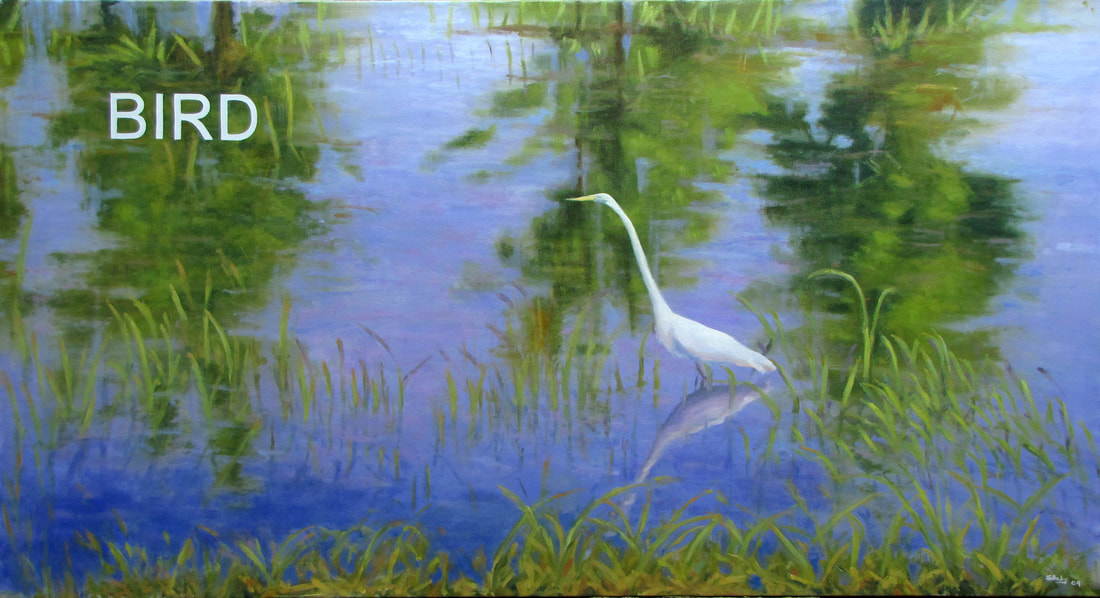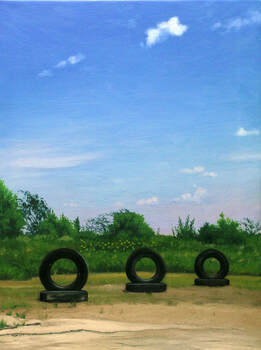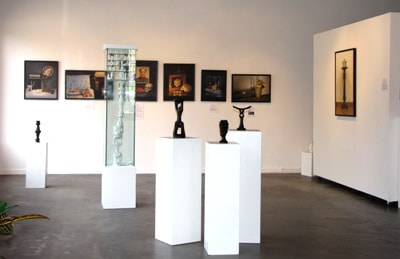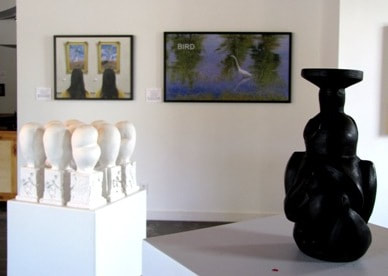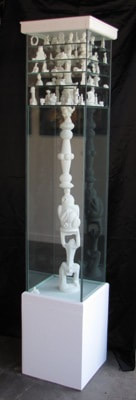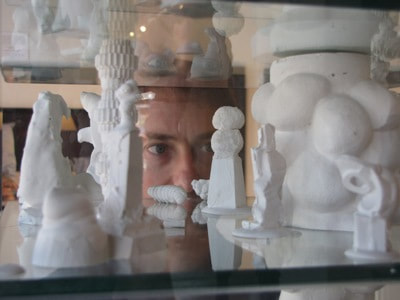S T I M U L U S
stimulating art for a depressed world
This series of conceptual paintings for a show at Archway Gallery in 2009. I shared the show with Jim Racine, a sculptor from England now living in Hong Kong.
This painting evolved from some of my reading on the philosophy of art. One definition of art claims that anything created with the intention of display for an audience constitutes art. Thus, Marcel Duchamp’s readymade art: common objects put on display as art. I thought as my own example this old pot that once belonged to my grand aunt. When used for cooking it is not art as it is serving another non-art purpose. However, once I put it on display for contemplation by an audience (using a pedestal that also was my grand aunt’s), it becomes art. And not bad art at that because it forces the viewer to really look at the pot and see its beauty in its shape, color, age and wear and tear (these Dada guys were onto something). The paradox of this piece is that I have painted a portrait of the readymade. There is nothing ‘readymade’ about the portrait and this gives rise to the title.
Honorable Mention, Visual Arts Alliance Show, Houston, TX, November, 2009
Honorable Mention, Visual Arts Alliance Show, Houston, TX, November, 2009
|
While strolling through the Louvre I came across a large still life, whose creator escapes me, that contained a skull peering into a mirror. As both the skull and mirror are symbols of vanitas, I was struck by the cleverness of this usage. In this piece, I have plagiarized, ugh I mean, I have been inspired by, this image. I have added to this the three candles and dead flower, further symbols of mortality. Additionally, the choice of flower is the tulip – a reference to all those Dutch masters. I have personalized the piece, and my own death obsession, by adding my image in the back of the mirror.
Any relationship between the Dutch tulip bubble and our current housing bubble are purely coincidental. Accepted into the Visual Arts Alliance Show, Houston, TX, May, 2010 |
Vanitas (Latin for ‘emptiness’) is a common theme portrayed in still lifes of the 17th century, where the trappings of the material world are displayed alongside some spiritual or mortality image to remind us of the transience of this world and the fleeting nature of youth and physical beauty. Here the jewelry, makeup, and mirror symbolize these trappings. The elaborate mirror reflects a girl, the symbol of youth and beauty, admiring an earring. It is aligned so that the girl’s position matches that of the viewer, thus involving the viewer in the piece. The cell phone shows her boyfriend, a further preoccupation of youth. I used an old photograph of my mother and great-grand uncle to serve as the memento mori or reminder of mortality. The antique mirror, an art nouveau piece which once belonged to my grand aunt, also serves this purpose. I intentionally added the cell phone to modernize the subject matter; except for which, the picture could be decades old.
Accepted into the Visual Arts Alliance Show, Houston, TX, May, 2008 |
|
This image came to mind while I was reading Christopher Hitchens’ God is Not Great where he was lamenting the sexual repression in which the young, especially males, are raised in the Muslim world: “...their problem is not so much that they desire virgins as that they are virgins…” Consider the enormous tension this must create in these young men – the desire for sex conflicted with their denial-based, misogynistic religious beliefs – and how this tension can be funneled into anger and lead to the suicidal killing of innocents.
Sadly, these beliefs on sex are not confined to Islam. The suicide bomber is simply the apotheosis of this belief system. The image here shows a “martyr” being raised from his self-destructive explosion to paradise to be greeted and cleansed by the long-desired Barbi-doll virgins; where the sexual desires can finally be sated in a guilt-free context. Significantly, his sex is covered by the Koran. For the setting, I chose the view from the Temple Mount that includes both the Wailing Wall – the holy Jewish site of Herod’s temple – and the Dome of the Rock – the site where Muhammad was supposedly taken to heaven. How tragic that both fairy tales lay claim to the same ground. |
While travelling in Paris I was surprised at the level of reverence the country holds for Napoleon – his image and his monuments pervade the capital. Yet contradictions arise upon close examination. Consider these two statements:
“History ended when Napoleon defeated the Prussians at the battle of Jena in 1806.” “Over 90,000 men died during Napoleon’s Waterloo campaign.” This first is a quote attributed to Hegel that I came across in Fukuyama’s “The End of History and the Last Man”. This interpretation of history credits Napoleon for destroying the monarchies of Europe and supplanting them with democracy and his eponymous legal code. The second is a simple statement of fact about the cost of one of his campaigns of conquest. Of course, greater minds than mine have had the same cognitive dissonance (see Beethoven, L. Van, et. al.). Worshiped as a liberator and then decried as a megalomaniac. What surprised me in Paris was the emphasis on the former and the disregard of the latter. So it seemed appropriate to temper the image of liberator/conqueror with a visceral reminder of the dark side of his victories and defeats. This is an image from the Arc d’Triumph of Jean-Pierre Cortot’s The Triumph of 1810 showing Napoleon being crowned victorious upon which are blood stains (relax, its just alizarin crimson). Accepted into the Visual Arts Alliance Show, Houston, TX, November, 2010 |
Some time ago I was thinking of the legacy of the German Idealist school of philosophy: Kant, Hegel, Marx and Nietzsche and the tremendous damage their philosophies wrought on the twentieth century, particularly Communism and Nazism. This crystallized for me when I read Jung Chang’s biography on Mao Tse Tung, which described his power hungry egomania that lead to the death of 75 million Chinese people and the irreparable loss of so much Chinese culture.
This still life brings to the fore all the elements of his misrule. The skull, of course, is the symbol of the deaths that he brought to the nation; the toy soldiers the military games he played solely for political purposes, particularly the long march (in which he didn’t do any marching) and the Korean war (a failed attempt to grind down the West and coerce the Soviets into giving him the Bomb); the flag the shallow patriotism used to manipulate people; the button the symbol of the cult of personality that he encouraged as well as the stack of the “Little Red Book” of his quotations - a work of abysmal boredom that I could not bring myself to finish. A collection of self-serving definitions and tautologies, it wasn’t even good for a laugh, unlike the hysterical “Communist Manifesto.” Here is just one gem:
“A revolutionary party is carrying out a policy whenever it takes any action. If it is not carrying out a correct policy it is carrying out an incorrect policy.”
Not exactly the Federalist Papers.
Also shown in the painting is a terracotta soldier from Xian, whose face has been broken – a symbol of the terror of the Cultural Revolution in which irreplaceable artifacts of Chinese culture were destroyed. (This, fortunately, is an anachronism, as these were not discovered until after the Cultural Revolution. Fortunately, since had then been known to exist, they would have been destroyed also.)
Lastly, is the rice bowl. This is a plain bowl typically used by peasants. It is cracked and empty symbolizing the famines created by Mao’s disastrous agricultural policy and exportation of goods used to generate revenue to fund the military. Beside this bowl are the destroyed remains of another. This one is red, typically used by the wealthy and represents the destruction not only of these people, but of the wealth of China as a whole.
Above all this hangs Mao’s famous portrait which today still haunts Tiananmen Square.
Honorable Mention, Visual Arts Alliance Show, Houston, TX, November, 2009
Accepted into Genocide, an exhibition at the Holocaust Museum, Houston, TX, September, 2016
This still life brings to the fore all the elements of his misrule. The skull, of course, is the symbol of the deaths that he brought to the nation; the toy soldiers the military games he played solely for political purposes, particularly the long march (in which he didn’t do any marching) and the Korean war (a failed attempt to grind down the West and coerce the Soviets into giving him the Bomb); the flag the shallow patriotism used to manipulate people; the button the symbol of the cult of personality that he encouraged as well as the stack of the “Little Red Book” of his quotations - a work of abysmal boredom that I could not bring myself to finish. A collection of self-serving definitions and tautologies, it wasn’t even good for a laugh, unlike the hysterical “Communist Manifesto.” Here is just one gem:
“A revolutionary party is carrying out a policy whenever it takes any action. If it is not carrying out a correct policy it is carrying out an incorrect policy.”
Not exactly the Federalist Papers.
Also shown in the painting is a terracotta soldier from Xian, whose face has been broken – a symbol of the terror of the Cultural Revolution in which irreplaceable artifacts of Chinese culture were destroyed. (This, fortunately, is an anachronism, as these were not discovered until after the Cultural Revolution. Fortunately, since had then been known to exist, they would have been destroyed also.)
Lastly, is the rice bowl. This is a plain bowl typically used by peasants. It is cracked and empty symbolizing the famines created by Mao’s disastrous agricultural policy and exportation of goods used to generate revenue to fund the military. Beside this bowl are the destroyed remains of another. This one is red, typically used by the wealthy and represents the destruction not only of these people, but of the wealth of China as a whole.
Above all this hangs Mao’s famous portrait which today still haunts Tiananmen Square.
Honorable Mention, Visual Arts Alliance Show, Houston, TX, November, 2009
Accepted into Genocide, an exhibition at the Holocaust Museum, Houston, TX, September, 2016
|
Many years ago a friend of mine met an old drunk on the subway in New York drinking this wine, which he jokingly referred to as ‘medicine’. He was a thin man and clearly overcome by his addiction. I bought a bottle as a gag for my friend, which we sampled. It tasted like Hawaiian punch and fuel-grade ethanol.
There also seems to be a fad in recent years of these very sophisticated looking wine bottle paintings. My purpose then is to contrast these works of sophisticated, high- class fine wines presented in lush surroundings with the other side of alcohol: cheap, low-class fortified wines imbibed by down-and-out addicts in a dark alley. |
An exploration into male sexuality and the conflict psychologists call the Madonna-whore dichotomy – the struggle between sexual and spiritual desires. The whore portion occupies the left side of the painting where lies a Swimsuit Issue of Sports Illustrated, which should truthfully be called the Masturbation Issue. The Madonna portion occupies the right side, where is placed a candle of the Madonna of Guadalupe as well as a Bible. The painting can also be seen as the struggle between the temporal and the spiritual.
Accepted into the Visual Arts Alliance Show, Houston, TX, November, 2010 |
This is a still life about old age where the medications to alleviate the decay of the body are arranged on a table top. The candle, which is a traditional symbol of mortality, is nearly burned out as we can presume is the life of the owner. The pill box is open to the eponymous day – deliberately chosen near the end of the week. The MRI images are my own, though my candle still has some wax left (I hope). The image of the young girl, presumably there to provide hope, is intentionally misleading. This young woman died at the age of eighteen, presenting the contrast between the life tragically cut short and the end game of senescence and decay.
|
This image appeared to me while visiting the Musee D’Orsay where my wife and her cousin sat sketching these Monet paintings of his wife. I modified the image somewhat, making their heights similar and changing their shirt colors to reflect the gold frames. I am particularly attracted by the two by two symmetry of the composition and the trompe l’oeil effect of the piece.
|
After so many painfully detailed still lifes, I like to let loose a little and do some impressionism. Copying Monet is one way to do this. Here, I took an image of an egret that I shot some years ago in George Bush Park after some heavy rains. Ramping up the color saturation made the image more Monet-like. Then I added “BIRD” for a little irreverence.
|
A fun image I found while driving the frontage road along the interstate towards Dallas. I was thinking of doing a figure piece on this famous subject, as it provides the artist with an opportunity for some great figure work. But one thing or another prevented me from getting three female models. So I had to substitute old tires.
Tires instead of women. How sad.
Tires instead of women. How sad.
